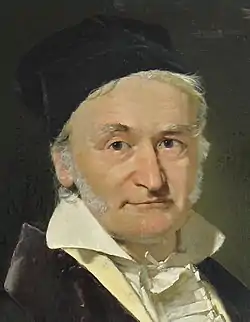Gauss's principle of least constraint
The principle of least constraint is one variational formulation of classical mechanics enunciated by Carl Friedrich Gauss in 1829, equivalent to all other formulations of analytical mechanics.

| Part of a series on |
| Classical mechanics |
|---|
Statement
The principle of least constraint is a least squares principle stating that the true accelerations of a mechanical system of masses is the minimum of the quantity
where the jth particle has mass , position vector , and applied non-constraint force acting on the mass.
The notation indicates time derivative of a vector function , i.e. position. The corresponding accelerations satisfy the imposed constraints, which in general depends on the current state of the system, .
It is recalled the fact that due to active and reactive (constraint) forces being applied, with resultant , a system will experience an acceleration .
Connections to other formulations
Gauss's principle is equivalent to D'Alembert's principle.
The principle of least constraint is qualitatively similar to Hamilton's principle, which states that the true path taken by a mechanical system is an extremum of the action. However, Gauss's principle is a true (local) minimal principle, whereas the other is an extremal principle.
Hertz's principle of least curvature

Hertz's principle of least curvature is a special case of Gauss's principle, restricted by the two conditions that there are no externally applied forces, no interactions (which can usually be expressed as a potential energy), and all masses are equal. Without loss of generality, the masses may be set equal to one. Under these conditions, Gauss's minimized quantity can be written
The kinetic energy is also conserved under these conditions
Since the line element in the -dimensional space of the coordinates is defined
the conservation of energy may also be written
Dividing by yields another minimal quantity
Since is the local curvature of the trajectory in the -dimensional space of the coordinates, minimization of is equivalent to finding the trajectory of least curvature (a geodesic) that is consistent with the constraints.
Hertz's principle is also a special case of Jacobi's formulation of the least-action principle.
See also
References
- Gauss, C. F. (1829). "Über ein neues allgemeines Grundgesetz der Mechanik". Crelle's Journal. 1829 (4): 232–235. doi:10.1515/crll.1829.4.232. S2CID 199545985.
- Gauss, C. F. Werke. 5. p. 23.
- Hertz, H. (1896). Principles of Mechanics. Miscellaneous Papers. III. Macmillan.
- Lanczos, Cornelius (1986). "IV §8 Gauss's principle of least constraint". The variational principles of mechanics (Reprint of University of Toronto 1970 4th ed.). Courier Dover. pp. 106–110. ISBN 978-0-486-65067-8.
- Papastavridis, John G. (2014). "6.6 The Principle of Gauss (extensive treatment)". Analytical mechanics: A comprehensive treatise on the dynamics of constrained systems (Reprint ed.). Singapore, Hackensack NJ, London: World Scientific Publishing Co. Pte. Ltd. pp. 911–930. ISBN 978-981-4338-71-4.
